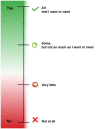Development and content validity of the Person Experiences Interview Survey (PEIS): a measure of the mental health services experiences of people with developmental disabilities
- PMID: 38098638
- PMCID: PMC10719843
- DOI: 10.3389/fpsyt.2023.1271210
Development and content validity of the Person Experiences Interview Survey (PEIS): a measure of the mental health services experiences of people with developmental disabilities
Abstract
Purpose: People with developmental disabilities and mental health service experiences have a right to be included in healthcare decisions, including the evaluation of their mental health services and providers. However, few self-report measures address this need. This study aimed to fill this gap by developing and evaluating the content validity, including comprehension, relevance, and comprehensiveness, of the Person Experiences Interview Survey (PEIS) with people with developmental disabilities and mental health experiences.
Methods: The research team established a measurement framework based on the Family Experiences Interview Survey (FEIS), resulting in 21 PEIS items that were written in collaboration with young adults with developmental disabilities and mental health service experiences. Comprehension, relevance, and comprehensiveness were evaluated through cognitive interviews with people with developmental disabilities and mental health service experiences (respondents; n = 9) ages 23-49 years. Comprehensiveness and relevance were also evaluated in focus groups with family caregivers (n = 9) and mental health providers (n = 10) who serve this population. Two researchers independently coded open-ended responses to the PEIS for comprehension. A content validity index (CVI), indicating relevance, was calculated for each participant group for each item, and comprehensiveness was rated for item sets.
Results: Fifteen of the 21 items met the criteria of ≥80% comprehension, with 89-100% of responses containing all or some intended information. All items met the CVI ≥80% criterion in at least two of the three groups. In all item sets, between 1 and 4 family members or providers felt one question was missing. Respondents used the response scale in a manner that corresponded with their open-ended descriptions, and family caregivers and providers had positive feedback about the response scale's visual cues and number of choices. Using these findings, four items were removed and six items were revised, resulting in a 17-item measure.
Conclusion: This study presents a novel and promising measure, the Person Experiences Interview Survey (PEIS). It also demonstrates that the employment of accessible methods allows people with developmental disabilities to meaningfully evaluate mental health services and providers. The PEIS shows great promise for application in the field by engaging those directly involved in the evaluation of mental health services and providers.
Keywords: developmental disabilities (MESH term); healthcare surveys (MESH term); mental health services (MESH term); patient-reported experience measure; self-report.
Copyright © 2023 Kramer, Beasley, Caoili, Kalb, Urquilla, Klein, Poncelet, Black and Tessler.
Conflict of interest statement
The authors declare that the research was conducted in the absence of any commercial or financial relationships that could be construed as a potential conflict of interest.
Figures
References
-
- Administration for Community Living , (n.d.) History of the developmental disabilities act Available at: http://acl.gov/about-acl/history-dd-act (Accessed July 28, 2023).
-
- Spassiani N, Abou Chacra MS, Lunsky Y. “Why are you Here? Can’t you cope at home?” the psychiatric crisis of people with intellectual disabilities and the community’s response. J Ment Health Res Intellect Disabil. (2017) 10:74–92. doi: 10.1080/19315864.2016.1278290 - DOI
Grants and funding
LinkOut - more resources
Full Text Sources
Miscellaneous


